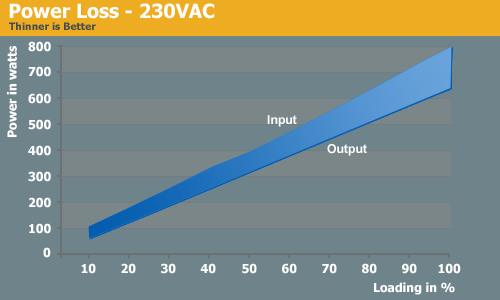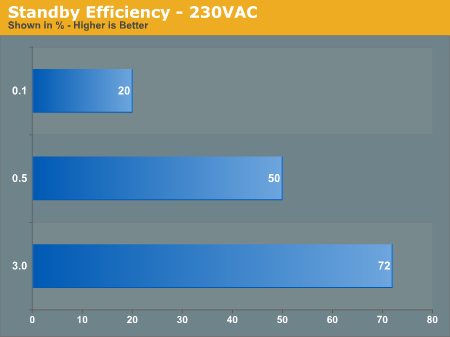The Single 12V Rail SilverStone Olympia OP650
by Christoph Katzer on July 13, 2007 12:00 PM EST- Posted in
- Cases/Cooling/PSUs
230VAC Efficiency, Power loss, PFC
With higher input voltage is the efficiency increases as well. We have measured a very nice 83.33% efficiency at just 40% load. In total we had more than 80% efficiency from 20 to 90% load which is a very good result from the OP650. This power supply will always provide good results in PCs with more than 130 watts constant load when connected to 230VAC power.

The loss of power is not that large as a result of the high efficiency at 230VAC. The upper line marks the power input and the lower line marks the output. The space in between is the power which has been lost during the work.

Again, we tested the standby power draw of the Silverstone supply, this time with 230VAC. With 230VAC the OP650 is using 1.7 watts of energy while doing "nothing" which is a slightly higher result than what we saw when connected to a 115VAC power grid. If you leave the PC off for a longer time you should always hit the switch or even unplug the cable. This not only saves you money, but could potentially help save wear and tear due to power surges, especially in areas with unreliable power.
The standby-efficiency was again tested with the loads of 0.1, 0.5 and 3.0 Ampere on the 5VSB rail while the power supply is not running. We see that the efficiency is slightly lower with 230VAC than with 115VAC. At 3 Ampere loading it is the same like with 115VAC.

The power factor correction with 230VAC was at an average level and working fine.

With higher input voltage is the efficiency increases as well. We have measured a very nice 83.33% efficiency at just 40% load. In total we had more than 80% efficiency from 20 to 90% load which is a very good result from the OP650. This power supply will always provide good results in PCs with more than 130 watts constant load when connected to 230VAC power.

The loss of power is not that large as a result of the high efficiency at 230VAC. The upper line marks the power input and the lower line marks the output. The space in between is the power which has been lost during the work.

Again, we tested the standby power draw of the Silverstone supply, this time with 230VAC. With 230VAC the OP650 is using 1.7 watts of energy while doing "nothing" which is a slightly higher result than what we saw when connected to a 115VAC power grid. If you leave the PC off for a longer time you should always hit the switch or even unplug the cable. This not only saves you money, but could potentially help save wear and tear due to power surges, especially in areas with unreliable power.
The standby-efficiency was again tested with the loads of 0.1, 0.5 and 3.0 Ampere on the 5VSB rail while the power supply is not running. We see that the efficiency is slightly lower with 230VAC than with 115VAC. At 3 Ampere loading it is the same like with 115VAC.

The power factor correction with 230VAC was at an average level and working fine.











46 Comments
View All Comments
meeshu - Thursday, July 19, 2007 - link
I would have liked to have seen results of ripple tests, regardless of whether they are within spec or not.Piyono - Sunday, July 15, 2007 - link
As your power supply testing methodology continues to evolve do you see yourself retesting previously reviewed units, if necessary? My concern is that all test results should be directly comparable between all reviewed units.Thanks,
Piyono
Christoph Katzer - Monday, July 16, 2007 - link
If it's possible (a matter of time) we will do it.Piyono - Sunday, July 15, 2007 - link
Very good first PS review.As an audio guy I feel it's necessary to point out that the *frequency* of the sound generated by a fan has a lot to do with how loud / annoying we might perceive it to be. The human ear, as we know, is not linear and is more sensitive at some frequencies than at others (for those unfamiliar with the concept, Google "Fletcher Munson equal loudness curve" or try the [url=http://en.wikipedia.org/wiki/Fletcher-Munson_curve...">http://en.wikipedia.org/wiki/Fletcher-Munson_curve...]Wikipedia entry[/url]).
For example, given two fans outputting 40dBSPL, one generating a tone centered at 1KHz will be far more annoying than one with a fundamental of 600Hz, simply because the ear is particularly sensitive around 1KHz, and less so at 600Hz.
Given the quality of your audio test equipment (great choice on the MG mic & pre, BTW) you can easily create an accurate frequency plot of the PS's audio output. Perhaps you could include these frequency plots in future reviews, along with sample recordings of the actual fan noise.
Just a thought.
I've been waiting a long time for a review site to pick up some chroma gear and put out consistent PS reviews. Kudos!
Piyono
mindless1 - Wednesday, July 18, 2007 - link
It can be problematic picking a high wattage PSU based on fan noise frequency. It is actually better to have a higher fan frequency for PSU lifespan, because that higher frequency is typically caused by use of ball bearings instead of sleeve bearing, which is much more reliable in a horizontally mounted PSU fan.If the noise is important I suggest you use a system that doesn't consume much power and has the older rearward facing fan (being a quality sleeve bearing, brand like Papst or Panaflo).
Christoph Katzer - Sunday, July 15, 2007 - link
Thanks, actually we are still working on the audio-equipment. When it's ready we will have quite some data to show.Piyono - Sunday, July 15, 2007 - link
Hey, that's good to know.I'm eager to see how this develops!
Piyono
xsilver - Saturday, July 14, 2007 - link
do silverstone manufacture this psu themselves or do they subcontract it to an OEM company like etasis?im most intrigued because they make the ZF series of psu's which have a dual PCB design
http://www.xbitlabs.com/articles/other/display/atx...">http://www.xbitlabs.com/articles/other/display/atx...
this review tells of how this is one of the very few psu's to actually have true independent voltage regulation; not sure how that has any real world effect but it at least looks like one of the most jam packed psu's i've ever seen.
Operandi - Saturday, July 14, 2007 - link
A good PSU review the proper way isn't an easy thing but it looks like you guys have an excellent handle on it, great work.maluckey - Saturday, July 14, 2007 - link
I noticed that the secondary heatsink temperature reached 90 degrees during testing. I've never been a fan of Teapo capacitors, and I suspect (though not stated in the article) that the caps on this PSU are NOT 105 C. caps. This means that given time, the degradation can be significant and the MTBF will rise accordingly. Can anyone justify 170 doolars a new PSU every couple of years? Especially when 35 dollars in better caps would change all that. It would basically future-proof your purchase, though the manufacturer would have to raise the price accordingly as they are not in the business of charity.I forsee this happening as soon as the majority of home users expect more from a PSU than a shiny case or blinky lights and a wildly opptimistic output rating.